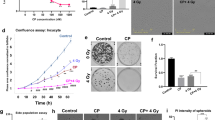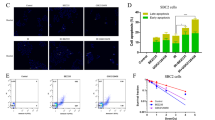Abstract
We recently identified inositol hexakisphosphate kinase 2 (IP6K2) as a positive regulator of apoptosis. Overexpression of IP6K2 enhances apoptosis induced by interferon-β (IFN-β) and cytotoxic agents in NIH-OVCAR-3 ovarian carcinoma cells. In this study, we contrast and compare IFN-β and radiation-induced death, and show that IP6K2 expression sensitizes tumor cells. Unirradiated NIH-OVCAR-3 cells transfected with IP6K2 formed fewer colonies compared to unirradiated vector-expressing cells. IP6K2 overexpression caused increased radiosensitivity, evidenced by decreased colony forming units (CFU). Both IFN-β and radiation induced caspase 8. IFN-β, but not γ-irradiation, induced TRAIL in NIH-OVCAR-3 cells. Gamma irradiation, but not IFN-β, induced DR4 mRNA. Apoptotic effects of IFN-β or γ-irradiation were blocked by expression of a dominant negative mutant death receptor 5 (DR5Δ) or by Bcl-2. Caspase-8 mRNA induction was more pronounced in IP6K2-expressing cells compared to vector-expressing cells. These data suggest that overexpression of IP6K2 enhances sensitivity of some ovarian carcinomas to radiation and IFN-β. IP6K2 may function to enhance the expression and/or function of caspase 8 and DR4 following cell injury. Both IFN-β and γ-irradiation induce apoptosis through the extrinsic, receptor-mediated pathway, IFN-β through TRAIL, radiation through DR4, and both through caspase 8. The function of both death inducers is positively regulated by IP6K2.
This is a preview of subscription content, access via your institution
Access options
Subscribe to this journal
Receive 50 print issues and online access
$259.00 per year
only $5.18 per issue
Buy this article
- Purchase on Springer Link
- Instant access to full article PDF
Prices may be subject to local taxes which are calculated during checkout






Similar content being viewed by others
Abbreviations
- AFC:
-
7-amino-4-trifluoromethyl coumarin
- CFU:
-
colony forming unit
- DISC:
-
death-inducing signaling complex
- DR:
-
death receptor
- DMF:
-
dose modification factor
- GAPDH:
-
glyceraldehyde-3-phosphate dehydrogenase; Gy, gray
- IETD:
-
Ile-Glu-Thr-Asp
- IFN:
-
interferon
- IP6K2:
-
inositol hexakisphosphate kinase 2
- RPA:
-
ribonuclease protection assay
- SRB:
-
sulforhodamine B
- TRAIL:
-
TNF-related apoptosis-inducing ligand
References
Belka C, Rudner J, Wesselborg S, Stepczynska A, Marini P, Lepple-Wienhues A, Faltin H, Bamberg M, Budach W, Schulze-Osthoff K . 2000 Oncogene 19: 1181–1190
Bodmer JL, Holler N, Reynard S, Vinciguerra P, Schneider P, Juo P, Blenis J, Tschopp J . 2000 Nat. Cell Biol. 2: 241–243
Bronner CE, Baker SM, Morrison PT, Warren G, Smith LG, Lescoe MK, Kane M, Earabino C, Lipford J, Lindblom A, Tannergard P, Bollag RJ, Godwin AR, Ward DC, Nordenskjøld M, Fishel R, Kolodner R, Liskay RM . 1994 Nature 368: 258–261
Burns TF, Bernhard EJ, El-Deiry WS . 2001 Oncogene 20: 4601–4612
Chawla-Sarkar M, Leaman DW, Borden EC . 2001 Clin. Cancer Res. 7: 1821–1831
Chou TC, Talalay P . 1984 Adv. Enz. Reg. 22: 27–55
Clarke AR, Purdie CA, Harrison DJ, Morris RG, Bird CC, Hooper ML, Wyllie AH . 1993 Nature 362: 849–852
Cuello M, Ettenberg SA, Nau MM, Lipkowitz S . 2001 Gynecol. Oncol. 81: 380–390
Decristofaro MF, Betz BL, Rorie CJ, Reisman DN, Wang W, Weissman BE . 2001 J. Cell Physiol. 186: 136–145
Gaidarov I, Krupnick JG, Falck JR, Benovic JL, Keen JH . 1999 EMBO J. 18: 871–881
Gong B, Almasan A . 2000 Cancer Res. 60: 5754–5760
Guan B, Yue P, Clayman GL, Sun SY . 2001 J. Cell Physiol. 188: 98–105
Hanakahi LA, Bartlet-Jones M, Chappell C, Pappin D, West SC . 2000 Cell 102: 721–729
Kischkel FC, Lawrence DA, Chuntharapai A, Schow P, Kim KJ, Ashkenazi A . 2000 Immunity 12: 611–620
Kok K, Osinga J, Carritt B, Davis MB, van der Hout AH, van der Veen AY, Landsvater RM, de Leij LF, Berendsen HH, Postmus PE, Poppema S, Buys CHCM . 1987 Nature 330: 578–581
Lackinger D, Eichhorn U, Kaina B . 2001 Mutagenesis 16: 233–241
MacFarlane M, Ahmad M, Srinivasula SM, Fernandes-Alnemri T, Cohen GM, Alnemri ES . 1997 J. Biol. Chem. 272: 25417–25420
Mehrotra B, Myszka DG, Prestwich GD . 2000 Biochemistry 39: 9679–9686
Morrison BH, Bauer JA, Kalvakolanu DV, Lindner DJ . 2001 J. Biol. Chem. 276: 24965–24970
Murakami M, Miyashita K, Kakizaki S, Saito S, Yamada M, Iriuchijima T, Takeuchi T, Mori M . 1995 Eur. J. Endocrinol. 133: 80–86
Norris FA, Ungewickell E, Majerus PW . 1995 J. Biol. Chem. 270: 214–217
Rimessi P, Gualandi F, Morelli C, Trabanelli C, Wu Q, Possati L, Montesi M, Barrett JC, Barbanti-Brodano G . 1994 Oncogene 9: 3467–3474
Saiardi A, Caffrey JJ, Snyder SH, Shears SB . 2000 FEBS Lett. 468: 28–32
Saiardi A, Erdjument-Bromage H, Snowman AM, Tempst P, Snyder SH . 1999 Curr. Biol. 9: 1323–1326
Sangfelt O, Erickson S, Castro J, Heiden T, Einhorn S, Grander D . 1997 Cell Growth Differ. 8: 343–352
Skehan P, Storeng R, Scudiero D, Monks A, McMahon J, Vistica D, Warren JT, Bokesch H, Kenney S, Boyd MR . 1990 J. Natl. Cancer Inst. 82: 1107–1112
Sprick MR, Weigand MA, Rieser E, Rauch CT, Juo P, Blenis J, Krammer PH, Walczak H . 2000 Immunity 12: 599–609
Taneja N, Tjalkens R, Philbert MA, Rehemtulla A . 2001 Oncogene 19: 167–177
Togashi S, Takazawa K, Endo T, Erneux C, Onaya T . 1997 Biochem. J. 326: 221–225
Voglmaier SM, Keen JH, Murphy JE, Ferris CD, Prestwich GD, Snyder SH, Theibert AB . 1992 Biochem. Biophys. Res. Commun. 187: 158–163
Yaginuma Y, Westphal H . 1992 Cancer Res. 52: 4196–4199
Ye W, Ali N, Bembenek ME, Shears SB, Lafer EM . 1995 J. Biol. Chem. 270: 1564–1568
York JD, Odom AR, Murphy R, Ives EB, Wente SR . 1999 Science 285: 96–100
Yount GL, Afshar G, Ries S, Korn M, Shalev N, Basila D, McCormick F, Haas-Kogan DA . 2001 Oncogene 20: 2826–2835
Zhang H, Koty PP, Mayotte J, Levitt ML . 1999 Exp. Cell Res. 247: 133–141
Acknowledgements
These studies were supported by a grant from the Taussig Cancer Center Bridge Grant Program to D Lindner. A Almasan was supported by grants from National Institutes of Health (CA81504 and CA82858). D Kalvakolanu was supported by grants from NCI and NIH (CA71401 and CA78282). We thank Drs ES Alnemri and SM Srinivasula (T Jefferson) for the DR5Δ construct.
Author information
Authors and Affiliations
Corresponding author
Rights and permissions
About this article
Cite this article
Morrison, B., Bauer, J., Hu, J. et al. Inositol hexakisphosphate kinase 2 sensitizes ovarian carcinoma cells to multiple cancer therapeutics. Oncogene 21, 1882–1889 (2002). https://doi.org/10.1038/sj.onc.1205265
Received:
Revised:
Accepted:
Published:
Issue Date:
DOI: https://doi.org/10.1038/sj.onc.1205265
Keywords
This article is cited by
-
PPIP5K2 promotes colorectal carcinoma pathogenesis through facilitating DNA homologous recombination repair
Oncogene (2021)
-
Inositol Pyrophosphates: Energetic, Omnipresent and Versatile Signalling Molecules
Journal of the Indian Institute of Science (2017)
-
The emerging roles of inositol pyrophosphates in eukaryotic cell physiology
Journal of Biosciences (2015)
-
IP6K gene identification in plant genomes by tag searching
BMC Proceedings (2011)
-
Inositol hexakisphosphate kinase 1 regulates neutrophil function in innate immunity by inhibiting phosphatidylinositol-(3,4,5)-trisphosphate signaling
Nature Immunology (2011)



